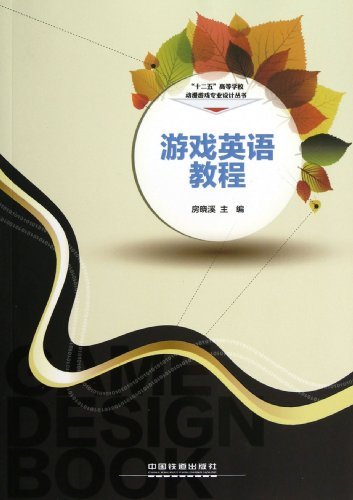暂无评论
图文详情
- ISBN:9787113159702
- 装帧:一般胶版纸
- 册数:暂无
- 重量:暂无
- 开本:26cm
- 页数:209
- 出版时间:2013-01-01
- 条形码:9787113159702 ; 978-7-113-15970-2
本书特色
《游戏英语教程》用5个部分32章的内容全面展示了国内外经典游戏案例并且论述了游戏的策划、美术设计、程序设计及运营全部过程的理论和实践。读者可以领略到原汁原味的国际国内经典游戏的特色及其共有规律,可以极大地提高读者设计和制作游戏的能力。本教材适合作为高等学校动漫游戏专业学生的教材,也可作为动漫游戏爱好者的参考用书。本书由北京吉利大学房晓溪任主编。
内容简介
本书用5个部分32章的内容全面展示了国内外经典游戏案例并且论述了游戏的策划、美术设计、程序设计及运营全部过程的理论和实践。
目录
PART Ⅰ INTRODUCTIONChapter 1 What Is Game1.1 Decision Making1.2 Goals1.3 Opposition1.4 Managing Resources1.5 Game Tokens1.6 InformationChapter 2 GameSpy's 7 Most Influential People in Gaming2.l EdFries (Microsoft)2.2 Alexey Pajitnov (Microsoft)2.3 Gabe Newell (Valve Software)2.4 John Romero (Monkcystone)2.5 John Carmack (ID Software)2.6 Sid Meier (Firaxis Games)2.7 Shigeru MiyamotoChapter 3 The Type of Game3.1 The Type of Game Design3.2 Sports Games3.3 Fighting Games3.4 Puzzle Games3.5 Real-time Strategy Games3.6 Role-playing Games3.7 First-person and Third-personAction Games3.8 SimulationsChapter 4 Fundamentals of Computers4.1 Cathode Ray Tube Technology4.2 Image PropertiesPART Ⅱ MACHINATEChapter 5 The Base5.1 Starting Points5.2 Establishing Focus5.3 Player Character Concepts5.4 Types of Props and Their Use5.5 Types of Items/Power-ups and PlacementChapter 6 Level6.1 Planning and Building6.2 Avoiding Common Level Mistakes6.3 The Process6.4 Level SeparationChapter 7 SeripUng7.1 Scripting in Games7.2 Scripting Technology Choices7.3 Using TriggerChapter 8 Documents8.1 The Necessary of Game Development Documents8.2 The Writing Style8.3 Story Bible8.4 The Sections8.5 Inauspicious Design DocumentsPART Ⅲ ARTChapter 9 Cartoon-looking Rendering of 3D scenes9.1 Introduction9.2 AlgorithmPART Ⅵ PROGRAMChapter 10 3D Math10.1 1D Mathematics10.2 Vector--A Geometric Definition10.3 Transforming an Object vs. Transforming the Coordinate Space10.4 What Is OrientationChapter 11 What Language Do I use11.1 C11.2 C++11.3 Should I Learn C++, or Should I Start with C11.4 Assembly11.5 Pascal11.6 Visual Basic11.7 Java11.8 Tools11.9 ConclusionChapter 12 Basic Concepts in DirectPlay12.1 Introduction12.2 Creating and Managing Sessions12.3 DirectPlay Network Communication12.4 Communicating with DirectPlay Objects12.5 DirectPlay Lobby SupportChapter 13 Client/Server Sessions13.1 Introduction13.2 Initiating a Client/Server Session13.3 Selecting a Service Provider for a Client13.4 Selecting a Client/Server Host13.5 Connecting to a Client/Server Session13.6 Managing a Client/Server Session13.7 Normal Client/Server Game Play13.8 Leaving a Client/Server Session13.9 Terminating a Client/Server SessionChapter 14 DirectPlay Lobby14.1 Introduction14.2 DirectPlay Lobby Architecture14.3 Lobby Servers14.4 Lobby Clients14.5 Lobbyable Applications14.6 Launching a Lobbyable ApplicationChapter 15 DirectPlay Callback Functions and Multithreading Issues15.1 Introduction15.2 DirectPlay Do Work Mode15.3 DirectPlay Thread Pool15.4 DirectPlay Networking CallbacksChapter 16 Engine Solutions and the Unreal EngineChapter 17 Direct3D Overview17.1 Introduction17.2 The REF Device17.3 D3DDEVTYPEChapter 18 Model Representation18.1 Introduction18.2 Vertex Formats18.3 Triangles18.4 IndicesChapter 19 Vertex/Index BuffersChapter 20 Bitmap FontsChapter 21 Your First PolygonChapter 22 Blending22.1 The Blending Equation22.2 Blending in OpenGL22.3 Note22.4 Alpha from Texture MapChapter 23 Advanced Collision Detection TechniquesChapter 24 Collision Detection and Particle Interaction24.1 Introduction24.2 A Quick Overview24.3 An Example24.4 Block Structure24.5 Notes on Block MapsChapter 25 Wu Anti-aliased Lines25.1 How Does It Work25.2 What Would the Ultimate Algorithm Be25.3 A More Sensible Algorithm25.4 Drawing the End Points25.5 Special CasesChapter 26 Real-time Dynamic Level of Detail Terrain Rendering with ROAM.
26.1 Triangle Fanning26.2 GeoMorphing26.3 Frame Coherence26.4 Supporting Larger TopologiesChapter 27 Fast Computation of Terrain Shadow Maps27.1 Introduction27.2 Algorithm Description27.3 Algorithm Implementation27.4 Lightmapping27.5 Color ComponentChapter 28 QuacltreesPART Ⅴ MOBILE PHONE MARKETChapter 29 Cellphones and Wireless Gaming29.1 Introduction29.2 Case Study CommentsChapter 30 J2ME30.1 Development Considerations30.2 The Kinds of Games30.3 Multiplay Cellphone GamingChapter 31 Career Choices31.1 Introduction31.2 Game Programming as a Career Choice31.3 Game Artist.as a Career Choice31.4 Game Designer as a Career Choice31.5 Production as a Career Choice31.6 Audio Composer and Engineer as a Career Choice31.7 QA as a Career ChoiceChapter 32 Career Guideline Worksheet32.1 If You Want to Explore Production32.2 If You Want to Explore Game Art Construction32.3 If You Want to Explore Game Programming32.4 If You Want to Explore Quality Assurance32.5 If You Want to Explore Game Audio32.6 If You Want to Explore Business Relations or MarketingGlossary
展开全部
本类五星书
浏览历史
本类畅销
-

穿鞋子的猫-法国童话集
¥4.8¥13.8 -

超级英雄典藏故事集
¥20.6¥98.0 -

山海经
¥22.4¥68.0 -

汉字百讲
¥21.8¥68.0 -

小王子
¥4.5¥15.0 -

颠倒的一天
¥12.8¥39.0 -

中国民间故事
¥9.4¥22.8 -

简笔画10000例
¥15.5¥49.8 -

小时候就在想的事(八品)
¥12.6¥39.5 -

今天要去动物园/那行童书
¥16.7¥49.0 -

格列佛游记/世界经典童话绘本
¥5.4¥15.0 -

诗词的故事典藏版(九品)
¥5.1¥19.8 -

写给孩子的趣味逻辑学
¥13.7¥38.0 -

中华姓氏地图
¥14.2¥59.8 -

尼尔斯骑鹅旅行记-亲近文学大师阅读世界经典-全译本
¥11.9¥36.0 -

怎样写作文-大师教我学知识
¥10.5¥25.0 -

会发光的小狮子:《恐龙世界奇遇记》
¥14.0¥52.0 -

101个趣味模块-101种创意游戏
¥13.2¥33.5 -

慢悠悠的压路车(八品)
¥14.4¥45.0 -

好慢好慢的毛毛虫公交车+甜甜圈逃跑啦
¥21.1¥78.0













